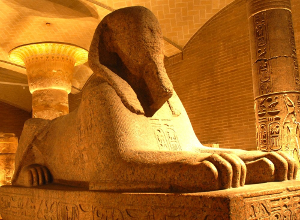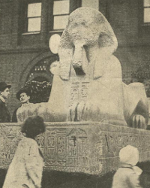|
Museum Moves Massive 'Mascot' Sphinx to Main Hall
June 13, 2019
A massive stone sphinx has moved from one part of a museum to another. The 13-ton statue representing Ramses II has sat in the Egypt Gallery of Philadelphia's Penn Museum since 1926. The technology used to move it didn't exist when the statue arrived at the museum. Museum officials used high-powered air compression to create a hoverboard-like transfer scenario and moved the statue 250 feet into the museum's main entrance hall. The first step was to create a 3D scan of the sphinx, to determine its weight and its density. Then, they employed a more traditional solution, a number of hydraulic gantries. That's when high tech took over. Workers placed the sphinx on a set of four air dollies that effectively floated the statue onto scaffolding, off which the hydraulic gantries took over again and put the sphinx on a track that resembled something used underneath a roller coaster. The rate of transport was very slow and involved travel through a removed door and window, around a few hairpin turns, and through another window. In planning the move, museum officials discovered that the building didn't match its blueprints. The Penn Museum launched a citywide promotion to publicize the move. Included in the promotion were the installation of five miniature sphinxes around the city and a series of Sphinx Riddles, the solvers of which gained prizes. Workers discovered the 3,000-year-old red granite human-lion sphinx, the largest of its kind in the Western Hemisphere, at the Temple of the God Ptah at Memphis. The sphinx, which has inscriptions that mention the famous 19th Dynasty pharaoh Ramses II, was a gift from the British School of Archaeology in Egypt and its famous director, Flinders Petrie, who offered the sphinx in exchange for the Penn Museum's support of the British excavations. The statue came to the U.S. in 1913 and was installed outside the museum. Three years later, officials moved the sphinx inside, through a side of the building that is now blocked. They moved it into the Lower Egypt Gallery in 1926. It has since become the museum's "unofficial mascot." |
Social Studies for Kids |
Social Studies for Kids
copyright 2002–2024
David White






